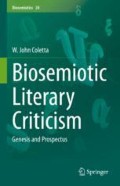Abstract
In this chapter, I explore what Timo Maran calls “Hierarchical Approaches to Biosemiotic Criticism.” Accordingly, I discuss three novels, Darwin’s Radio, by Greg Bear; Clay’s Ark, by Octavia E. Butler; and, The Overstory, by Richard Powers, novels that dramatize how, as Maran writes, “we are not uniform subjects, but rather hierarchical structures that contain many interacting layers of organization, all of which have their own subjectivity, memory, and semiotic competence” (Biosemiotic criticism. Chapter 14. In G. Garrard (Ed.), The Oxford handbook of ecocriticism. Oxford/New York: Oxford University Press, 2014b). Darwin’s Radio and Clay’s Ark, two titles based on two parallel possessives that hint ironically at how we do not possess ourselves, provide characters, themes, and plots that allow for an explication both of how we not ourselves (not uniform subjects) when looking inward (the domain of what Thomas Sebeok calls “endosemiotics,” and how we are also not ourselves (not uniform subjects) when looking outward (a domain open to analysis in terms of what Susan Petrilli calls “semioethics” [From the semiotic animal to the semioethic animal: The humanism of otherness and responsibility. In J. Deely, S. Petrilli, & A. Ponzio (Eds.), The semiotic animal (pp. 67–86). New York, Ottawa, Toronto: Legas, 2005]). Concepts such as Lynn Margulis’s “symbiogenesis” (explored at length in Myra Hird. The origins of sociable life: Evolution after science studies. New York: Palgrave Macmillan, 2009), Hoffmeyer’s “semiogenic creativity” (Biosemiotics: An examination into the signs of life and the life of signs. Scranton and London: University of Scranton Press, 2008), and René Thom’s “nervous system lateralization” (Semio physics: A sketch (Vendla Meyer, Trans.). Redwood City: Addison-Wesley Publishing Co., Inc., 1990) are woven tother in my articulation of my “semiotic-animal principle” and my “third-body phenomenon” concept.
Access this chapter
Tax calculation will be finalised at checkout
Purchases are for personal use only
References
Bear, G. (1999). Darwin’s radio. New York: Ballantine Books.
Bourdieu, P. (1977). Outline of a theory of practice. Cambridge: Cambridge U Press.
Butler, O. (1984). Clay’s ark. New York: Warner Books.
Deely, J. (2010). Semiotic animal: A postmodern definition of human being transcending patriarchy and feminism. South Bend: St. Augustine’s Press.
Deely, J., Petrilli, S., & Ponzio, A. (2005). The semiotic animal. New York, Ottawa, Toronto: Legas.
Deleuze, G., & Guattari, F. (1987). A thousand plateaus: Capitalism and Schizophrenia (B. Massumi, Trans.). Minneapolis: University of Minnesota Press.
Emmeche, C., Kull, K., & Stjernfelt, F. (2002). A biosemiotic building: 13 theses. In R. Hoffmeyer (Ed.), Rethinking biology (pp. 13–24). Tartu: Tartu University Press.
Heisenberg, M. (2009). Is free will an illusion? Nature, 459, 164–165.
Hird, M. J. (2009). The origins of sociable life: Evolution after science studies. New York: Palgrave Macmillan.
Hoffmeyer, J. (2008). Biosemiotics: An examination into the signs of life and the life of signs. Scranton and London: University of Scranton Press.
Leder, D. (1990). The absent body. Chicago: University of Chicago Press.
Mansfield, N. (2000). Subjectivity: Theories of the self from Freud to Haraway. New York: New York University Press.
Maran, T. (2014). Biosemiotic criticism. Chapter 14. In G. Garrard (Ed.), The Oxford handbook of ecocriticism. Oxford/New York: Oxford University Press.
Margulis, L. 1992 (1981). Symbiosis in cell evolution. New York: W. H. Freeman and Co
Margulis (Sagan), L. (1967 March). On the origin of mitosing cells. Journal of Theoretical Biology, 14(3), 225–274.
Margulis, L., & Sagan, D. (1986). Microcosmos: Four billion years of microbial evolution. New York: Simon and Schuster.
Peirce, C. S. CP 1931–1958. Collected papers of Charles Sanders Peirce. C. Hartshorne, P. Weiss (Eds.) (Vols. 1–6) (1931–1935) and A. Burks (Ed.) (Vols. 7–8) (1958). Cambridge, MA: Harvard University Press. [References to Peirce’s papers will be designated by CP, followed by volume and paragraph number].
Peirce, C. S. (1992). In N. Houser & C. Kloesel (Eds.), The essential Peirce: Selected philosophical writings (Vol. 1 (1867–1893)). Bloomington and Indianapolis: Indiana University Press. [References to this volume will be designated with an EP 1992 followed by the page number].
Petrilli, S. (2005). From the semiotic animal to the semioethic animal: The humanism of otherness and responsibility. In J. Deely, S. Petrilli, & A. Ponzio (Eds.), The semiotic animal (pp. 67–86). New York, Ottawa, Toronto: Legas.
Pine, R. (1975–1976). Course handout. In Glossary of ecological terms. Chicago: George Williams College.
Powers, R. (2018). The overstory. New York and London: W. W. Norton & Company.
Sebeok, T. A. (1985 [1976]). Contributions to the doctrine of signs. Bloomington: Indiana UP.
Thom, R. (1990). Semio physics: A sketch (trans. by Vendla Meyer). Redwood City, CA: Addison-Wesley Publishing Co., Inc.
Uexküll, Jakob von. (1982). The theory of meaning. Semiotica 42(1): 25–82.
Wolfe, C. (2003). Animal rites: American culture, the discourse of species, and posthumanist theory. Chicago: University of Chicago Press.
Author information
Authors and Affiliations
Rights and permissions
Copyright information
© 2021 Springer Nature Switzerland AG
About this chapter
Cite this chapter
Coletta, W.J. (2021). Hierarchical Approaches to Biosemiotic Literary Criticism. In: Biosemiotic Literary Criticism. Biosemiotics, vol 24. Springer, Cham. https://doi.org/10.1007/978-3-030-72495-5_5
Download citation
DOI: https://doi.org/10.1007/978-3-030-72495-5_5
Published:
Publisher Name: Springer, Cham
Print ISBN: 978-3-030-72494-8
Online ISBN: 978-3-030-72495-5
eBook Packages: Literature, Cultural and Media StudiesLiterature, Cultural and Media Studies (R0)

